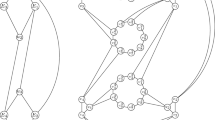Abstract
We tackle the maximum clique problem by reformulating it in terms of a standard quadratic program, which derives from a theorem of Motzkin and Straus. A heuristic is then obtained by solving with Lemke’s method the linear complementarity problem that arises from the KKT conditions of the QP. We have added a pivoting rule that exploits degeneracy to reach good suboptimal solutions. Very positive results have been obtained on the DIMACS benchmark graphs.
Preview
Unable to display preview. Download preview PDF.
Similar content being viewed by others
References
Bomze, I. M. (1997). Evolution towards the maximum clique. J. Global Optim., 10: 143–164.
Bomze, I. M., Budinich, M., Pardalos, P. M., and Pelillo, M. (1999). The maximum clique problem. In Du, D.-Z. and Pardalos, P. M., editors, Handbook of Combinatorial Optimization - suppl. vol. A, pages 1–74. Kluwer Academic Publishers.
Bomze, I. M., Budinich, M., Pelillo, M., and Rossi, C. (2000). A new “annealed” heuristic for the maximum clique problem. In Pardalos, P. M., editor, Approximation and Complexity in Numerical Opti-mization. Kluwer Academic Publishers.
Cottle, R. W., Pang, J., and Stone, R. E. (1992). The Linear Complementarity Problem. Academic Press, Boston, MA.
Gibbons, L. E., Hearn, D. W., and Pardalos, P. M. (1996). A continuous-based heuristic for the maximum clique problem. In Johnson, D. and Trick, M. A., editors, Cliques, colouring and satisfiability, volume 26 of DIMACS Series, pages 103–124. AMS.
Motzkin, T. S. and Straus, E. G. (1965). Maxima for graphs and a new proof of a theorem of Turán. Canada J. Math., 17 (4): 533–540.
Pardalos, P. M. and Phillips, A. T. (1990). A global optimization approach for solving the maximum clique problem. Int. J. of Comput. Math., 33: 209–216.
Pelillo, M. (2000). Replicator dynamics in combinatorial optimization. In Pardalos, P. M. and Floudas, C. A., editors, Encyclopedia of Optimization. Kluwer Academic Publishers, Boston, MA.
Pelillo, M. and Jagota, A. (1995). Feasible and infeasible maxima in a quadratic program for the maximum clique problem. J. Artif. Neural Networks, 2 (4): 411–420.
Author information
Authors and Affiliations
Editor information
Editors and Affiliations
Rights and permissions
Copyright information
© 2001 Kluwer Academic Publishers
About this chapter
Cite this chapter
Massaro, A., Pelillo, M. (2001). A Pivoting-Based Heuristic for the Maximum Clique Problem. In: Hadjisavvas, N., Pardalos, P.M. (eds) Advances in Convex Analysis and Global Optimization. Nonconvex Optimization and Its Applications, vol 54. Springer, Boston, MA. https://doi.org/10.1007/978-1-4613-0279-7_23
Download citation
DOI: https://doi.org/10.1007/978-1-4613-0279-7_23
Publisher Name: Springer, Boston, MA
Print ISBN: 978-0-7923-6942-4
Online ISBN: 978-1-4613-0279-7
eBook Packages: Springer Book Archive




